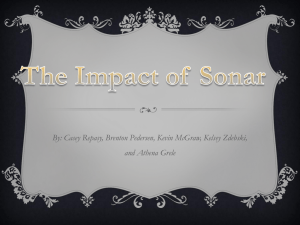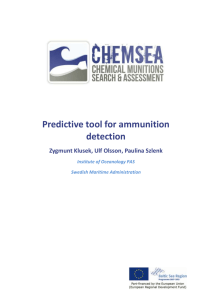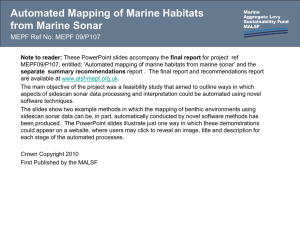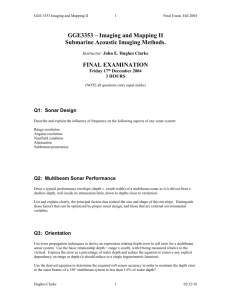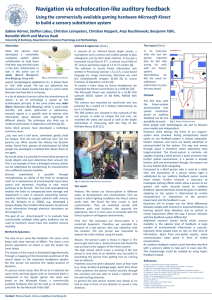Paper Title: Linear Feature Prediction for Confidence
advertisement
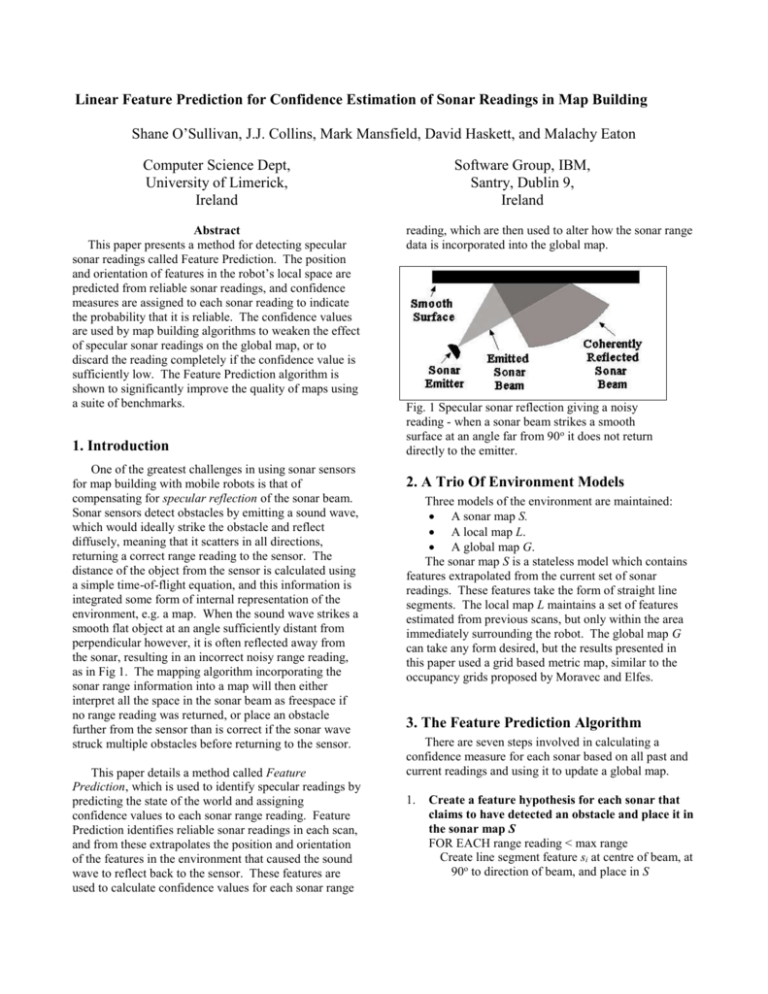
Linear Feature Prediction for Confidence Estimation of Sonar Readings in Map Building Shane O’Sullivan, J.J. Collins, Mark Mansfield, David Haskett, and Malachy Eaton Computer Science Dept, University of Limerick, Ireland Abstract This paper presents a method for detecting specular sonar readings called Feature Prediction. The position and orientation of features in the robot’s local space are predicted from reliable sonar readings, and confidence measures are assigned to each sonar reading to indicate the probability that it is reliable. The confidence values are used by map building algorithms to weaken the effect of specular sonar readings on the global map, or to discard the reading completely if the confidence value is sufficiently low. The Feature Prediction algorithm is shown to significantly improve the quality of maps using a suite of benchmarks. 1. Introduction One of the greatest challenges in using sonar sensors for map building with mobile robots is that of compensating for specular reflection of the sonar beam. Sonar sensors detect obstacles by emitting a sound wave, which would ideally strike the obstacle and reflect diffusely, meaning that it scatters in all directions, returning a correct range reading to the sensor. The distance of the object from the sensor is calculated using a simple time-of-flight equation, and this information is integrated some form of internal representation of the environment, e.g. a map. When the sound wave strikes a smooth flat object at an angle sufficiently distant from perpendicular however, it is often reflected away from the sonar, resulting in an incorrect noisy range reading, as in Fig 1. The mapping algorithm incorporating the sonar range information into a map will then either interpret all the space in the sonar beam as freespace if no range reading was returned, or place an obstacle further from the sensor than is correct if the sonar wave struck multiple obstacles before returning to the sensor. This paper details a method called Feature Prediction, which is used to identify specular readings by predicting the state of the world and assigning confidence values to each sonar range reading. Feature Prediction identifies reliable sonar readings in each scan, and from these extrapolates the position and orientation of the features in the environment that caused the sound wave to reflect back to the sensor. These features are used to calculate confidence values for each sonar range Software Group, IBM, Santry, Dublin 9, Ireland reading, which are then used to alter how the sonar range data is incorporated into the global map. Fig. 1 Specular sonar reflection giving a noisy reading - when a sonar beam strikes a smooth surface at an angle far from 90 o it does not return directly to the emitter. 2. A Trio Of Environment Models Three models of the environment are maintained: A sonar map S. A local map L. A global map G. The sonar map S is a stateless model which contains features extrapolated from the current set of sonar readings. These features take the form of straight line segments. The local map L maintains a set of features estimated from previous scans, but only within the area immediately surrounding the robot. The global map G can take any form desired, but the results presented in this paper used a grid based metric map, similar to the occupancy grids proposed by Moravec and Elfes. 3. The Feature Prediction Algorithm There are seven steps involved in calculating a confidence measure for each sonar based on all past and current readings and using it to update a global map. 1. Create a feature hypothesis for each sonar that claims to have detected an obstacle and place it in the sonar map S FOR EACH range reading < max range Create line segment feature si at centre of beam, at 90o to direction of beam, and place in S 2. 3. Compare each feature in S, si, with all the other features in S, sj, to determine if they represent the same object in the environment. FOR EACH si in S FOR EACH sj in S NOT EQUAL TO si IF similar(si , sj) THEN Create new feature sk between si and sj and place it in S Remove si and sj from S Remove any feature in S caused by incorrect readings. Confidence values derived from the 5. Remove si from S and remove lj from L FOR EACH si in S Place si in L as a new segment Remove si from S Features in L too far from the robot are removed FOR EACH li in L IF dist(robot_position, last_position_detected(li)) > Td THEN Remove li from L 6. Generate final sonar confidence values, c da . For any segment in L that should have been detected but was not, split in two and shorten it. Confidence values derived from the local model L are denoted with a superscript L, with the formula used to calculate the confidence value s sonar view are denominated by c x , where the s signifies that this confidence value was derived from the sonar view, and x indicates the formula used to calculate it. An L superscript signifies that the confidence value was derived from the local map L. is the difference in angle between the sonar and the feature, and is the beam aperture. FOR EACH sonj in SONARS L referred to with a subscript, as in c x . FOR EACH soni in SONARS c aL c dL 0.5 FOR EACH lj in L IF inconsistent(si , sonj) THEN IF soni should sense lj if it exists THEN c as c ds c aL c dL 0.5 FOR EACH si in S IF inconsistent(si , sonj) THEN IF sonj should detect si THEN 90 c aL 0.5 * 0.25 90 c as 0.5 * 0.25 Divide lj at point of intersection with sonj, creating lk and ll Remove lj from L and insert lk and ll into L Reduce length of lk and ll IF length( lk ) < TL Remove lk from L IF length( ll ) < TL Remove ll from L IF soni should not sense lj if it exists THEN ELSE IF sonj should not detect si cds R 2 2 s c da combine c as , c as FOR EACH li in L IF inconsistent(li , sonj) THEN IF sonj should detect li THEN 90 c aL 0.5 * 0.25 ELSE IF sonj should not detect li cdL R 2 2 L c da combine c aL , c aL FOR EACH si in S IF si detected by only 1 sonar AND ( c da Ts OR c da Ts ) THEN s 4. L Remove si from S Compare all remaining features in S with all lines in L, refining the hypothesis of the angle and position of the features in L FOR EACH si in S FOR EACH lj in L IF similar(si , lj) THEN Create new feature between si and lj and place it in L L cdL R 2 2 L c da combine c aL , c aL 7. Use sonar confidence values to alter how the sonar information is integrated into the global map. The implementation of this step is specific to the method being used to generate the global map. 4. Calculating Confidence Values A sonar beam is represented as three lines, as in Fig 4. If none of the three lines intersect with a feature, then that sonar is given a confidence value c da 0.5 , where X is X either s or L. The value 0.5 is used due to the fact that when it is used in a Bayesian update formula, it has no effect. If any of the three lines intersects with a feature either in S or L then the sonar is inconsistent with that X X feature. At this point, either c d or c a must be calculated. If the difference in orientation between the sonar and the feature is less than 25o (given a beam aperture of 25o), then the sonar should detect the feature if the feature were at the predicted position and orientation. In this case, the closer to perpendicular the sonar is to the feature, the more likely it is to detect it. As stated earlier, the initial confidence value of each sonar is 0.5. X Therefore the confidence with regard to angle, c a , is calculated as: 90 c aX 0.5 * 0.25 This maps the confidence value into the range [0.25, 0.5], meaning that a feature which should have been detected by the sonar can, at worst, halve the confidence in the sonar. If the difference in orientation between the sonar beam and the feature it is inconsistent with is more than 25 o from perpendicular, then the sonar would not be expected to detect the feature, assuming that it is a smooth obstacle. In this case the confidence in the sonar, Fig. 4. The predicted features in the sonar model S after Step 1. The robot is facing straight into a wall with sonars 2, 3, 4 and 5 returning a reading that is less than the maximum range. Sonars 0, 1 and 6 return no reading, and sonar 5’s reading, while less than the maximum, is incorrect. The min/max possible angles the line segments is in the [ ] brackets beside each line. c dX is directly proportional to the distance from the sonar to the feature. cdX R 2 2 When a range reading is inconsistent with a feature, only the are behind the feature is updated incorrectly as being freespace. The closer the feature is to the sonar, the lower the confidence value must be to prevent the cells behind the feature being effected by the map building algorithm, as can be seen in Fig 2 and Fig 3. Fig. 2. Sonar beam with an undetected feature at distance 1 from the emitter. The darker the area, the more strongly it is believed to be unoccupied. Fig. 3. Sonar beam with undetected obstacle 2 from the emitter. The strength of the freespace update has been reduced. Fig. 5. Predicted features after Step 2 is applied to the sonar view from Fig 4. The three line segments S1 S2 and S3 have been merged to create one segment as their min/max ranges overlap, and they are sufficiently close. 5. Combining Confidence Values s s Once c d and c a have been computed, they are combined to give a single confidence value for the sonar, s c da . The confidence combination formulae are derived from techniques for parallel combination of rules in expert systems [1], with the full derivation available in [2]. 2 cds cas when cds 0.5 and cas 0.5 s cda s s s s cd ca 0.5 when cd 0.5 or ca 0.5 Fig. 6. State of the sonar model S after Step 3 has been applied. Sonar 5 is inconsistent with the line created by sonars 2, 3 and 4, and its confidence is low enough so that the line predicted by it has been removed. 6. Experimentation Results A suite of benchmarking techniques published in [3] have been applied to 128 maps generated with and without feature prediction, both in simulation and in real world experiments on a Pioneer 1 robot from ActivMedia robots. Each of the maps generated in the course of experimentation are compared against hand drawn ideal maps of the environment the robot traversed. A complete description of all environments, benchmarks, and procedures followed can be obtained from [2]. The four tests are as follows: 1. Correlation. A technique from the image recognition field that tests the similarity of two maps using the average and standard deviation the cells, as well as comparing the maps on a cell-to-cell basis. A higher percentage indicates a greater degree of similarity between the maps.[4] 2. Map Score. A technique developed by Martin and Moravec [5] which calculates the difference between two maps by summing the squared difference of corresponding cells in each map. The lower the percentage difference, the greater the similarity between the two maps. 3. Map Score of Occupied Cells. Similar to the previous benchmark, but only tests those cells that are occupied, i.e. >0.5 in one or both of the maps being tested. 4. Path Comparison For False Positive Paths. Examines the freespace areas of a map by calculating the percentage of paths in the map which would cause a robot to collide with an obstacle. The lower the percentage, the fewer paths would cause a collision, and therefore the better the map. Correlation Map Map Score Path Comparison Score Occupied False Positives Cells Without 59.77% 13.80% 11.05% 59.60% Feature Prediction With 71.56% 9.18% 7.80% 40.20% Feature Prediction 6.1 Analysis of Results All four benchmarks show considerable improvement in map quality when Feature Prediction is applied. The correlation benchmark shows the map quality increasing by 120%. The Map Score benchmark shows the map quality increasing by 150%. The Map Score of Occupied Cells shows an increase in map quality of 142%. The Path Comparison for False Positive Paths benchmark shows an increase of 148%. 7. Discussion This paper presented a method of detecting specular sonar reflections and assigning confidence values to the sonar range readings in order to enable more accurate map building. Experiments which employed the Feature Prediction algorithm with a simple two-dimensional gaussian sonar model from [6] showed an average increase of map quality of 140% over four different benchmarks. Performing Feature Prediction requires a negligible amount of computational resources, with a standard desktop workstation capable of performing mapping for ten or more robots simultaneously. However it vastly increases the quality of a map, resulting in more effective navigation routines. References 1. Heckerman, D. 1986. “Probabilistic interpretation 2. 3. 4. 5. 6. for MYCIN's uncertainty factors.” Uncertainty in Artificial Intelligence. L. N. L. Kanal, J.F. NorthHolland: 197-196. O’Sullivan, S. 2003. An Empirical Evaluation Of Map Building Methodologies in Mobile Robotics Using The Feature Prediction Sonar Noise Filter And Metric Grid Map Benchmarking Suite. MSc Thesis, University of Limerick, Ireland. Collins, J. J., O’Sullivan, S., Mansfield, M., Eaton, M., Haskett, D. 2004. “Developing an extensible benchmarking framework for map building paradigms.”. In Proceedings Ninth International Symposium on Artificial Life and Robots, Oita, Japan, January 2004. Baron, R. J. 1981. "Mechanisms of human facial recognition." International Journal of Man Machine Studies 15: 137-178. Martin, M. C., Moravec, H.P. 1996. “Robot Evidence Grids.” Robotics Institute, Carnegie Mellon University, Pittsburgh, Pennsylvania Moravec, H. P., Elfes, A. 1985. “High Resolution Maps from Wide Angle Sonar.” Proceedings of the 1985 IEEE International Conference on Robotics and Automation.

